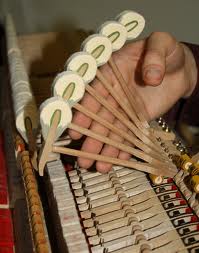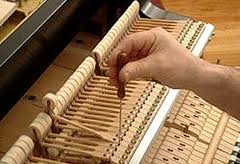
In the following articles you will find answers to many piano repair questions. Let’s start with Vertical Piano Regulation.
The proper touch on your piano depends on it being regulated. To many pianists, a piano’s touch is as important as its tone. Touch refers to the efficiency and responsiveness of the mechanical action of the piano, and is what is responsible for giving a piano its full range of power from the silkiest of pianissimos to a crashing double forte. When a piano begins to lose its mechanical efficiency, it is said to have gone out of regulation. Exacting measurements and corresponding adjustments are needed to put a piano back into regulation. The adjustments of your piano action related to touch have not been attended to recently and are causing the piano to be less than responsive. A job of regulation is in order.
The following commonly asked questions have been answered to give you the information you need in order to decide whether or not to have me regulate your piano:
What exactly would cause a piano to go out of regulation? Weren’t necessary adjustments set at the factory?
To a greater or lesser degree your piano would have been regulated at the factory where it was built. Fine quality instruments obviously receive more attention than models on the low end of the price spectrum, and as such have a better touch from the beginning, but even the finest quality piano will go out of regula- tion over time.
The action of the vertical piano is truly a mechanical marvel. Perfected be- fore the turn of the last century, its remarkable design is still in use today. Although the operation of the piano may seem simple from the outside, inside it is in fact very complex. When a note on your piano is played, the energy from your finger instantly puts a carefully balanced system of levers and springs into motion.
Eight pivot points (five shown) swing the combination of parts into action. Felt cushions at all contact points prevent action noise from intruding upon the music 
The primary reason that the action of a piano goes out of regulation is that the felt parts (over two dozen per note) which are so important to the functioning of the action become worn and compressed with age and use. As compression occurs, adjustments to the contact points which were made when the piano was new no longer are accurate. As this happens, a gradual loss of performance occurs. Lost motion in the action prevents maximum power from being transmitted from the keys to the strings when forte is called for. Early release of the hammers causes misfiring notes when subtle pianissimos are attempted. Double-striking notes become more and more of an annoyance. Although the change occurs over time, at some point it starts to become obvious that the piano is not performing up to par.
Could I have a description in detail of how one particular regulation adjust- ment is made?
In leveling natural keys, one of several measurement tools will be used to ascertain the exact height of each key. Pictured is the Jaras Multi- Functional Device being used to measure the amount of height which needs to be added to each key to bring it up to level. Other tools which might be used to complete this job would be a straightedge, or Davis Key Leveler
Once the measurement has been made for the key, leveling papers are added at the balance rail to bring the height of the key up to level. Papers as thin
as .001" are used to produce a perfectly level set of keys. After all the keys have been leveled, the leveling papers and the bal- ance rail felts will be flipped so that the felts are on top.
So, thats just the beginning. Make sure to follow up with the next blog to have a few more questions answered. Thus helping you decide if and when you need to have your piano repaired.






